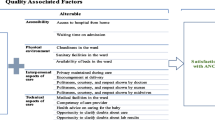Abstract
Objectives To explore sociodemographic determinants of perceived quality of antenatal care (ANC) at the primary care level. Methods A survey of 452 randomly selected pregnant women accessing antenatal care at the primary healthcare facilities in Sagamu Local Government Area (LGA) of Ogun State, southwest Nigeria. The relationships between 13 sociodemographic characteristics of women and their overall perception of the quality of care (expressed by their level of overall satisfaction) were examined through bivariate analyses, by computing odds ratio at 95% confidence interval. Multivariate logistic regression analyses were used to determine independent sociodemographic determinants of overall satisfaction with quality of care received. A P-value <0.05 or CI which did not embrace unity was considered as statistical significance. Results From bivariate analyses, increasing parity, increasing number of living children, gainful employment of client and Islamic religion increases the likelihood of positive perception of antenatal care quality. Characteristics such as age, being married, women’s monthly earning, ethnicity, employment status of husband, educational level, duration of pregnancy, frequency of antenatal visits, and previous use of antenatal care at the same centre were not associated with overall satisfaction with antenatal care quality. Independent predictors from multivariate regression analyses include parity (adjusted OR 0.13; CI: 0.05–0.33, P = 0.005) and religion (other religions vs. Islam; adjusted OR: 0.14, CI: 0.04–0.40, P = 0.0003). Conclusions The study suggests that sociodemographic characteristics of women have limited impact on their perception of ANC quality. The identified predictors may serve as the criteria for selecting women that require intensive health centre-specific antenatal interventions aimed at improving perceived quality and thus sustained utilization of antenatal care services in these primary health care facilities.
Similar content being viewed by others
References
World Health Organization. (1994). Mother-Baby package: Implementing safe motherhood in developing countries. Practical Guide. Document WHO/FHE/MSM/94.11. Geneva: World Health Organization.
United Nations. United Nations website: http://www.un.org/millenniumgoals/. Accessed 06/08.
WHO & UNICEF. (2003). Antenatal Care in developing countries: promises, achievements and missed opportunities: An analysis of trends, levels, and differentials, 1990–2001. Geneva, Switzerland: World Health Organization.
Federal Ministry of Health. (2005). Fact sheet on Safe Motherhood. Abuja: FMOH.
Adeoye, S., Ogbonnaya, L. U., Umeorah, O. U., & Asiegbu, O. (2005). Concurrent use of multiple antenatal care providers by women utilising free antenatal care at Ebonyi State University Teaching Hospital, Abakaliki. African Journal of Reproductive Health, 9, 101–106.
Lamina, M. A., Sule-Odu, A. O., & Jagun, O. E. (2004). Factors militating against delivery at Olabisi Onabanjo University Teaching Hospital. Factors militating against delivery among patients booked in Olabisi Onabanjo University Teaching Hospital, Sagamu. Nigerian Journal of Medicine, 13, 52–55.
Baltussen, R. M., Ye, Y., Haddad, S., & Sauerborn, R. S. (2002). Perceived quality of care of primary health services in Burkina Faso. Health Policy and Planning, 17, 42–48. doi:10.1093/heapol/17.1.42.
Haddad, S., Potvin, L., & Pineault, R. (1992). Do satisfaction studies measure attributes of patients or the characteristics of the services provided? In M. K. Chytil, G. Duru, W. Van Eimeren, & C. D. Flagle (Eds.), Health Systems, the Challenge of Change. Fifth international Conference on Health System Science (pp. 1169–1173). Prague: Omnipress Publisher.
Hall, J. A., Roter, D. L., & Katz, N. R. (1987). Tasks vs. socio-emotional behaviors in physicians. Medical Care, 25, 399–412. doi:10.1097/00005650-198705000-00004.
Oladapo, O. T., Iyaniwura, C. A., & Sule-Odu, A. O. Quality of antenatal services at the primary care level in southwest Nigeria. African Journal of Reproductive Health (in press).
Centres for Disease Control and Prevention (CDC), Family Health International (FHI), World Health Organization (WHO). (1994) .Sample size and power. In P. A. Wingo, J. E. Higgins, G. L. Rubin, & S. C. Zahniser (Eds.), An epidemiologic approach to reproductive health (pp. 151–200). Geneva: World Health Organization.
Nigenda, G., Langer, A., Kuchaisit, C., Romero, M., Rojas, G., Al-Osimy, M., et al. (2003). Womens’ opinions on antenatal care in developing countries: Results of a study in Cuba, Thailand, Saudi Arabia and Argentina. BMC Public Health, 3, 17. doi:10.1186/1471-2458-3-17.
Langer, A., Nigenda, G., Romero, M., Rojas, G., Kuchaisit, C., Al-Osimi, M., et al. (1998). Conceptual bases and methodology for the evaluation of women’s and providers’ perception of the quality of antenatal care in WHO Antenatal Care Randomised Controlled Trial. Paediatric and Perinatal Epidemiology, 12(Suppl. 2), 98–115. doi:10.1046/j.1365-3016.1998.00009.x.
Bruce, J. (1990). Fundamental elements of the quality of care: A simple framework. Studies in Family Planning, 21, 61–91. doi:10.2307/1966669.
Jain, A. K. (1989). Fertility reduction and the quality of family planning services. Studies in Family Planning, 20, 1–16. doi:10.2307/1966656.
Turan, J. M., Bulut, A., Nalbant, H., Ortayh, N., & Akalin, A. A. K. (2006). The Quality of hospital-based antenatal care in Istanbul. Studies in Family Planning, 37, 49–60. doi:10.1111/j.1728-4465.2006.00083.x.
Centres for Disease Control and Prevention (CDC) and World Health Organization.Epi Info 2002. (2002). Database and statistics software for public health professionals. Atlanta, Georgia, USA: Centres for Disease Control and Prevention.
Acknowledgments
The authors acknowledge the contributions of Dr. Q.A. Yusuf, Director of Primary Health Care of Sagamu Local Government, Drs. O. Ayoola-Sotubo, F.O. Inofomoh, R.O. Kehinde, O. Odusolu and O. Oladipupo. We are also grateful to all the pregnant women and personnel at the study sites for their contributions towards the success of this study.
Author information
Authors and Affiliations
Corresponding author
Rights and permissions
About this article
Cite this article
Oladapo, O.T., Osiberu, M.O. Do Sociodemographic Characteristics of Pregnant Women Determine their Perception of Antenatal Care Quality?. Matern Child Health J 13, 505–511 (2009). https://doi.org/10.1007/s10995-008-0389-2
Received:
Accepted:
Published:
Issue Date:
DOI: https://doi.org/10.1007/s10995-008-0389-2




